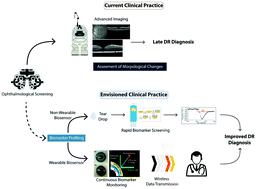Our official English website, www.x-mol.net, welcomes your feedback! (Note: you will need to create a separate account there.)
Lab-on-a-chip technologies for minimally invasive molecular sensing of diabetic retinopathy
Lab on a Chip ( IF 6.1 ) Pub Date : 2022-04-29 , DOI: 10.1039/d1lc01138c Maria Vieira 1 , Rosa Fernandes 2, 3, 4, 5 , António F Ambrósio 2, 3, 4, 5 , Vanessa Cardoso 6, 7 , Mariana Carvalho 1 , Peng Weng Kung 8 , Miguel António Dias Neves 9 , Inês Mendes Pinto 1, 9
Lab on a Chip ( IF 6.1 ) Pub Date : 2022-04-29 , DOI: 10.1039/d1lc01138c Maria Vieira 1 , Rosa Fernandes 2, 3, 4, 5 , António F Ambrósio 2, 3, 4, 5 , Vanessa Cardoso 6, 7 , Mariana Carvalho 1 , Peng Weng Kung 8 , Miguel António Dias Neves 9 , Inês Mendes Pinto 1, 9
Affiliation

|
Diabetic retinopathy (DR) is the most common diabetic eye disease and the worldwide leading cause of vision loss in working-age adults. It progresses from mild to severe non-proliferative or proliferative DR based on several pathological features including the magnitude of blood–retinal barrier breakdown and neovascularization. Available pharmacological and retinal laser photocoagulation interventions are mostly applied in the advanced stages of DR and are inefficient in halting disease progression in a significantly high percentage of patients. Yet, recent evidence has shown that some therapies could potentially limit DR progression if applied at early stages, highlighting the importance of early disease diagnostics. In the past few decades, different imaging modalities have proved their utility for examining retinal and optic nerve changes in patients with retinal diseases. However, imaging based-methodologies solely rely on morphological examination of the retinal vascularization and are not suitable for recurrent and personalized patient evaluation. This raises the need for new technologies to enable accurate and early diagnosis of DR. In this review, we critically discuss the potential clinical benefit of minimally-invasive molecular biomarker identification and profiling of diabetic patients who are at risk of developing DR. We provide a comparative overview of conventional and recently developed lab-on-a-chip technologies for quantitative assessment of potential DR molecular biomarkers and discuss their advantages, current limitations and challenges for future practical implementation and continuous patient monitoring at the point-of-care.
中文翻译:

用于糖尿病视网膜病变微创分子传感的芯片实验室技术
糖尿病视网膜病变 (DR) 是最常见的糖尿病眼病,也是全球工作年龄成年人视力丧失的主要原因。根据包括血-视网膜屏障破坏和新生血管形成的程度在内的几种病理特征,它从轻度非增殖性或增殖性 DR 进展。可用的药理学和视网膜激光光凝干预主要应用于 DR 的晚期阶段,并且在相当高比例的患者中无法有效阻止疾病进展。然而,最近的证据表明,如果在早期阶段应用某些疗法可能会限制 DR 进展,这突出了早期疾病诊断的重要性。在过去的几十年里,不同的成像方式已证明它们可用于检查视网膜疾病患者的视网膜和视神经变化。然而,基于成像的方法仅依赖于视网膜血管的形态学检查,不适合复发性和个性化的患者评估。这提高了对新技术的需求,以实现对 DR 的准确和早期诊断。在这篇综述中,我们批判性地讨论了微创分子生物标志物识别和分析有发展为 DR 风险的糖尿病患者的潜在临床益处。我们提供了传统和最近开发的芯片实验室技术的比较概述,用于定量评估潜在的 DR 分子生物标志物,并讨论了它们的优势,
更新日期:2022-04-29
中文翻译:

用于糖尿病视网膜病变微创分子传感的芯片实验室技术
糖尿病视网膜病变 (DR) 是最常见的糖尿病眼病,也是全球工作年龄成年人视力丧失的主要原因。根据包括血-视网膜屏障破坏和新生血管形成的程度在内的几种病理特征,它从轻度非增殖性或增殖性 DR 进展。可用的药理学和视网膜激光光凝干预主要应用于 DR 的晚期阶段,并且在相当高比例的患者中无法有效阻止疾病进展。然而,最近的证据表明,如果在早期阶段应用某些疗法可能会限制 DR 进展,这突出了早期疾病诊断的重要性。在过去的几十年里,不同的成像方式已证明它们可用于检查视网膜疾病患者的视网膜和视神经变化。然而,基于成像的方法仅依赖于视网膜血管的形态学检查,不适合复发性和个性化的患者评估。这提高了对新技术的需求,以实现对 DR 的准确和早期诊断。在这篇综述中,我们批判性地讨论了微创分子生物标志物识别和分析有发展为 DR 风险的糖尿病患者的潜在临床益处。我们提供了传统和最近开发的芯片实验室技术的比较概述,用于定量评估潜在的 DR 分子生物标志物,并讨论了它们的优势,



























 京公网安备 11010802027423号
京公网安备 11010802027423号